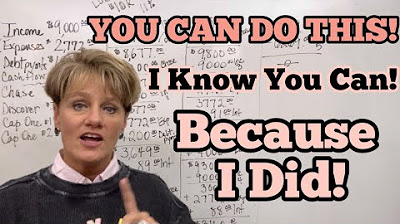Credit Card Debt Explained With a Glass of Water
Summary
TLDRThis video highlights the dangers of making only minimum payments on credit card debt. It explains that with $10,000 of credit card debt and a 17% interest rate, it could take 36 years to pay off, costing over $60,000 in the process. The video uses a glass of water as a metaphor for the debt, showing how each small minimum payment barely reduces the balance due to high interest. The message encourages viewers to take more aggressive action to pay down their debt faster, preventing long-term financial strain and significant interest costs.
Takeaways
- 💳 Making only minimum payments on credit card debt can take decades to pay off.
- 💧 A large debt of $110,000 is used as a metaphor for the water level in a glass that needs to be emptied.
- 💵 The average minimum payment is around $142, which barely makes a dent in the total debt.
- 📉 After paying the minimum, interest rates of around 17.7% can quickly negate the payment made.
- 🔄 The cycle of making minimum payments and accruing interest results in minimal debt reduction.
- 📈 Even after a year of payments, the debt reduction is minimal, only lowering by $5.
- 🚫 The slow debt reduction means it takes a significant amount of time to see any substantial progress.
- 💼 If action is taken to lower debt, money could be used for more valuable things like education or a car.
- 🏦 After 25 years, with consistent minimum payments and interest, the debt is only reduced by $1,578.
- 🕒 It takes 35 years of consistent payments to finally see a significant reduction in debt, with over $60,000 spent.
- 💰 The total amount spent on interest over 36 years could have been used for significant life improvements or savings.
Q & A
What is the average minimum payment for credit card debt?
-The average minimum payment for credit card debt is around $142.
If you have $110,000 in credit card debt, how much do you reduce it by after making one minimum payment?
-After making one minimum payment, the debt is reduced by only $1, from $9,999 to $9,998.
What is the impact of interest on credit card debt after making a minimum payment?
-Interest charges around 17.7% of the outstanding balance at the end of every month, which can negate the reduction made by the minimum payment.
How much debt reduction can be expected after making a year of minimum payments?
-After a year of making minimum payments, the debt is reduced by only $5.
How much money would you have paid to the credit card company after a year of minimum payments?
-After a year of making minimum payments, you would have paid $1,846 to the credit card company.
What is the total amount of money spent on interest after 35 years of making minimum payments?
-After 35 years of making minimum payments and paying 17% interest every month, you would have spent over $40,000 on interest.
How much debt would you still owe after 35 years of making minimum payments on a $10,000 debt?
-After 35 years, you would still owe $1,578 on the original $10,000 debt.
How long does it take to pay off the entire $10,000 debt by only making minimum payments?
-It takes 36 years to pay off the entire $10,000 debt by making minimum payments.
What is the total amount spent to pay off the $10,000 debt after 36 years of minimum payments?
-The total amount spent to pay off the $10,000 debt after 36 years is over $60,000.
What are some alternative uses for the money that would have been spent on interest over 36 years?
-The money spent on interest could have been used for a used car, a brand new car, part of a child's college education, grad school, paying mortgage or rent, or retirement savings.
What is the final debt amount after 36 years of making minimum payments and paying 17% interest every month?
-After 36 years, the final debt amount is $0, but it takes a significant amount of time and money to reach this point.
Outlines

هذا القسم متوفر فقط للمشتركين. يرجى الترقية للوصول إلى هذه الميزة.
قم بالترقية الآنMindmap

هذا القسم متوفر فقط للمشتركين. يرجى الترقية للوصول إلى هذه الميزة.
قم بالترقية الآنKeywords

هذا القسم متوفر فقط للمشتركين. يرجى الترقية للوصول إلى هذه الميزة.
قم بالترقية الآنHighlights

هذا القسم متوفر فقط للمشتركين. يرجى الترقية للوصول إلى هذه الميزة.
قم بالترقية الآنTranscripts

هذا القسم متوفر فقط للمشتركين. يرجى الترقية للوصول إلى هذه الميزة.
قم بالترقية الآنتصفح المزيد من مقاطع الفيديو ذات الصلة

Cut credit card interest costs by exceeding minimum payments

How to Pay Off ALL of Your Maxed Out Credit Cards with NO CASHFLOW!!!

How to Pay Off A Credit Card with 0 Cash Flow!

Financial Literacy - 9 things a college student should know (Part 2)

How to Pay Off Your Maxed Out Credit Cards with ZERO Cashflow!!!| @JustJWoodfin

She Did, Too! $28,000+ In Credit Card Debt Pays Off Within 6 Months
5.0 / 5 (0 votes)
